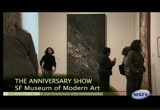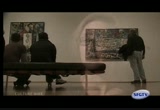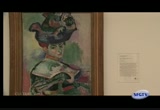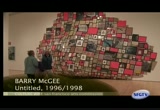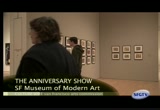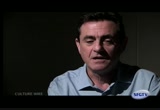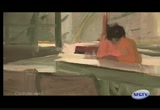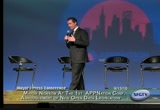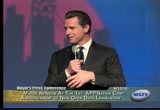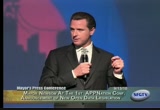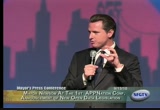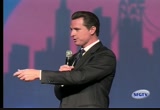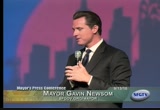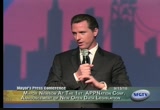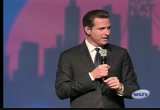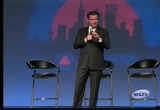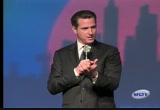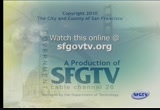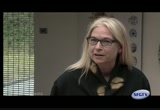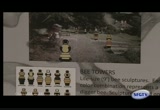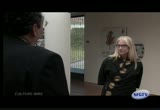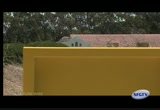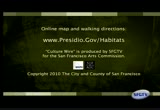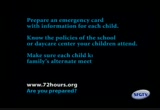tv [untitled] September 28, 2010 5:00pm-5:30pm PST
6:00 pm
his patient and support from many individuals who give their collections -- and broad support from many individuals who give their collections to the museum. this year it will be celebrating and abolishing those individuals through exhibition -- and acknowledging those individuals throughout asia. joining me is janet bishop, the curator. i understand you have been with the museum quite a number of years. you remember its original home on van ness. now you are part of that transition to the center, the civic center, and of course your museum has been really the anchor of cultural tenants that has helped us transform this area of the city. >> to my mind, it is wonderful
6:01 pm
to be part of such a rich cultural community. when visitors come to this area, that have so many different options. >> let's talk about the anniversary show, which will be a phenomenal opportunity for san franciscans and all visitors of the city to get a real sense of how the city has grown and the importance of culture. >> we focus on moments where it was involved in pushing the dialogue about contemporary art forward. the jackson pollock exhibition in 1945 is a perfect example of that. our founding director was deeply interested in abstraction and was engaged in dialogue with the guggenheim about bringing the jackson pollack showed to the west coast. the original price for the painting, $750. are directors thought that was too much of a stretch before the board of trustees, so she
6:02 pm
convinced them to reduce the price to firefighter dollars. it was just -- to $500. it was what was needed to persuade the board. it is a very subjective history of art. it has been very much shaped by the individuals involved with the museum over the years. in 1935, would start with the gallery with works that came in through albert bender, one of our founding trusties. when we opened our doors in 1935, 181 of the 186 pieces in our permanent collection had been gifted. >> what are the names that pop out as the museum evolved? >> we have another gallery that looks at the theories that the museum has since the late 1980's. we focus on a particular aspect
6:03 pm
of that program that developed under one of art curators. he arrived in 1989 and was especially interested in artists. >> are some of the highlights? >> one of the aspects of the museum program that i have been especially involved with have been the exhibitions that stand for society for the encouragement of contemporary art. it is encouraged to honor exceptional bay area artists during their careers. for instance, an early worked who showed here in 1996. for this exhibition, he has extended an updated it to 2010 with the addition of photographs and other frameworks. >> thank you for joining us. >> my pleasure.
6:04 pm
>> as we examine the 75th anniversary, we cannot overlook its important role as an educational institution and how it brings public program to all of our citizens in the bay area. try me now to talk about that is dominick, the curator of education and public programs. you are vested with a multifaceted responsibility, with education and also multimedia. could you explain that? >> there are three main areas. we produce education activities for all ages, k-12, and adults, and we also produce a lot of educational media, a lot of interviews with artists, stuff that we published online, and
6:05 pm
other galleries. there's also a public program, which include some educational activities, but also live cultural programming for the artists projects. >> what are all the ways that the museum reaches out? >> the latest platform for educational media is launching right now with his anniversary. we have gotten to the point where we could put a lot of the content about artists, the stories behind artists we have had on line, but those on to the ipod touch. >> could you talk about the education role that the museum plays in the city of san francisco? >> we are in the middle of a new initiative to provide more resources and programs for families and the locality. we are benefiting from a grant
6:06 pm
from the wallace foundation, and in the last two years many more bay area families have come to the museum, participated in the programs, most of which take place on sundays. we will see more and more different offerings rolled out in the coming months. >> thank you, dominic, for being part of "culture wire." >> the museums are almost like a team sport. there is a tremendous amount of talented staff that puts together patrons to help support the institutions, but they all need a coach. the coach is the director. neal, could you let the viewers know, you have been director how long? >> we are working on eight years. >> now you have the 75th anniversary. how does that feel?
6:07 pm
>> we opened this building in 1995. it was bought at that time as a move from the civic center and the veterans building 2 third street, into our new building, a much expanded space, better space. it will be wonderful for the museum for decades to come. and 15 short years we have been amazed by we have outgrown the building. the collection has grown to 26,000 works. >> was a challenging to decide what was going to be put on display during the anniversary year? >> 3 people on our staff spent 2 1/2 years of going through archives, the storage vaults, honor think all kinds of works that we have not seen -- uncovering lot of works that we have not seen but also history we uncovered about how we
6:08 pm
presented a television show produced by the museum, in the museum, in 1950. a lot of great stories that the presentation tells. >> the most recent news was the incredible decision on the part of donna morris fisher to give their collection to sfmoma. >> think it is commonly understood that the fischer collection was 1100 works by some of the great contemporary works, one of the great collections in the world. in fact, the collection has not been seen. it has been largely stored at the headquarters, there has never been a publication or exhibition. >> but fischer collection and the additional expansion over the next 50 years, what in the
6:09 pm
next 25 years will the museum be doing? >> we are very committed to expanding the museum, expanding the collection, the overall growth of the museum. that is one of the things that is very important to us. we are about to enter a strategic planning process. the fundamental question we want to address is, how wil sfmoma growth and enhanced its engagement with the community? it is not enough that the museum has great works in its collection, has great exhibitions, wonderful education programs, it is how does the institution grow and enhance its relationship with the community. it is very important to us. >> on behalf of the residents of san francisco, we thank you for shepherding this institution through this incredible growth phase, and thank you for being part of "culture wire."
6:10 pm
>> my pleasure, thank you. >> the museum has exciting anni >> thank you. thank you. thank you for being here. >> santa clara graduate. truth be told. i couldn't get into cal and berkeley. it is not all about cal and berkeley. but of course drew is a better baseball player and moved on in his life and i'm stuck in public service which is hardly a place to feel stuck. i'm very enlivened by it, but i'm trying to make public life more entrepreneurial. that's why i'm here. i am here because i admire the work you're doing and i'm frustrated by what we do in government, it it doesn't necessarily match the entrepreneurial and innovative
6:11 pm
spirit alive in this room and nom the city and state but across the country and the world. i want to say a few things. we're in san francisco, in one of the most diverse cities and the dirs states and the world's most diverse democracy. people are prospering and living together across the most imaginable difference. why do i say that? birthplace, united nations, why do i bring that up? i do at the end of the day make this strong point, that nothing matters more than our capacity to recruit and retain the best and the brightest minds from around the world. that what makes san francisco, what makes this state, what makes this country special at our best is that quality of imagination. that innovative and entrepreneurial spirit, that ability to retain the best and brightest minds. that's why it is right that we're in a city that doesn't
6:12 pm
tolerate its diverseity. we celebrate it each and every day. that human capital, that differentiater. that is alive and well today because you wouldn't be here had it not been for that differentiater. you have a million other cities that you could be doing this first conference, but you chose san francisco, the birthplace of life science and biotechnology, the home of the california stem cell institute, one of the most dynamic cities still in this very difficult economic climate, the -- the home of twitter and companies like wikipedia, sales force.com. four square as he was mentioning. all of these remarkable companies that are now starting to take shape here in san francisco. play fish, the gaming industry really taking off. zinga and the work that mark is doing and their growth and that potential, all taking shape in
6:13 pm
this small city that we call home. again, because this is where the talent about that ability to recruit and retain the best and the brightest minds. almost 0-plus percent. not almost, over 40% of the people in the city have bachelor's degrees or greater. not many cities have that concentration of talent. at the end of the gay, the primary function of a mayor is -- to create the conditions so we could create an environment where people like you can come to -- together and do extraordinary things. now, back to my point, i won't take too much of your time, government -- government needs that entrepreneurial spirit now more than ever for -- for obvious reasons. two that are self-evident to all of you. one, we're broke. the soaked, you don't have that much confidence -- the second,
6:14 pm
you don't have much confidence to solve your problems. we're better off taking inspiration from you and the private sector and trying to inject it into government as we know it. my friend tim o'reilly came to me a couple of years ago and said, he started talking about the notion that -- of government as it -- as a vending machine. and that -- you basically pay yore taxes then offproscribed list of products and services, you basically pull the lever and that product or service is dispensed. that's it. that's rather one dimensional. the at some point to have you our consumers, the taxpayers, the shareholders to design government in your interest, individually and collective is limitless. that's really what -- what i am looking -- looking forward to in terms of the work that you're doing. not just for your own interests but -- not just for your private interests but for the public
6:15 pm
good. that's why a year and a half ago, with tim and others, we came together and we put together an open data strategy for city government. we took a bunch of information and put it together and said, it is yours. this is your government, this is your information, now go at it. now figure out something to do with this information. something we could never have imagined and my gosh, got forbid would take us a year or two to go through a procurement process. you'll have to do an r.f.i. an r.f.q., r.f.p., lowest responsive bidder. then go through a process and where it goes through hearings and the county board makes their way to the mayor's office and by the time you get it out there, we run out of money and nothing happens. you on the other hand have taken
6:16 pm
information and in realtime put applications now that exist days, in some cases hours after we put the data, you had days weeks and months and the cost to the taxpayers is zero. let me give you specific examples. we have an application showcase. if you go to s.f. data.org, you'll get the data we put up. we're barely getting started, we only have 150 data, we're getting started and tomorrow coincidentally, i'm going to acquire with the ordinance, diane executive order and codify with an ordinance to make san francisco government responsible for putting up thousands of data from every city department. be it the department of environment, be it the department of public works, be it the police department and the fire department, et cetera to do the following. we put muni information up,
6:17 pm
company out of nowhere comes together and calls roots and takes information that exists so you could go on your p.d.a. and instead of worrying about whether we're on time with the public transit, you could find ow in realtime exactly when the bus will arrive. you got mothers that came together, because -- they actually -- are working more collaboratively to celebrate a lot of work that has been done to our play grounds in san francisco and they put together a mom map application, which uses the g.p. snfment your hand and can tell you where a play ground or park is within your area. you have got crime mapping that is being done now so if you you want to make sure you come to san francisco and you're nervous and you read about the tragedy with the tourist and you're not confident, you're going to stay at a hotel, you're not sure if the tenderloin is the right place, you could go on this
6:18 pm
crime mapping,.com, application, and you could get all of the latest realtime crime mapping data. well ahead of anything that the city itself produces. we -- we're doing this for literally dozens and dozens of applications. how about this? how many of you, i imagine, everyone, some of you may never have had this indignity. not waking up in time when those street sweepers are outside. it is as government purposely does this to you. you're working hate and it is 5 a.m. they do the street sweeping. why not 7:00 our 8:00 or 9:00. it is always that hour or two before and you don't want to wake up. now we have an application. we were going to spend 30,000 to put this together, it would have taken us months to go through that procurement process. and folks came can up like that for no cost. now we have an application that
6:19 pm
will tell you and warn you when those street sweepers are coming so you don't get outrageous tickets. these are the kind of things that are very practical that make a big difference in your lives. very soon incidentally, you're going to be able to go. this is the first city in america that has congestion parking meter prying, where you have an inventory of all of the on-street parking spaces and you're going to determine the availability of parking in realtime on your p.d.a., so you don't have to circle around the corner 20, 30 times. called s.f. park. again, three dimensional, this is the future of government. real transparency. real accountability. you designing government in your image. i think this is an extraordinary thing. i think this conference is extraordinary. i think you'll laak back and remember this day, five 10 years from now when you can't get in the conference. when they can't just use north
6:20 pm
but south, but the other masconi we'll be building because hundreds of thousands of people are trying to descend in the region to take advantage of the extraordinary moment in time and that moment has you will create as you build again that quality of imagination and move your ideas forward. i just wanted to be here and -- as that local government representative saying please don't forget about us. transparency, accountability, efficiency, and real-time information, in the hands of the people that determine it the most, the taxpayers themselves. government not as a vending machine, but government as something all together different. it is -- it is -- it is your mind, it is in your imagination now, and i'm just here to encourage you to unleash it. let you know that san francisco wants to continue to play a role, front and centre and this
6:21 pm
6:22 pm
>> hello, i'm meg, welcome to "culture wire." for this episode, the director of cultural affairs, luis, will take you on a journey through presidio has been tet. -- presidio habitat. >> welcome to "culture wire." today i'm at the presidio trust, a treasure within san francisco, because the presidio trust is really a national park in the center of an urban setting. it dates to the very founding of the city.
6:23 pm
national park. toting me today to talk about this amazing exhibition at presidio habitat is cheryl hanes. can you tell me a little bit about the idea of the presidio habitat? >> succinctly, i have been long involved in the presidio. i was here when it was still a military base in the 1980's. i remember driving down walmart to the golden gate bridge and seeing the military guard at the gate and being utterly fascinated. >> so presidio habitat is an exhibition where you have invited, how many artists to think about the habitat? >> we put together a list of possible participants, local,
6:24 pm
national, or international, of people who are concerned with environmental concerns, made some sort of contribution to the landscape and conversation we're having here. we said that broke -- proposal requests and we received 25 back. from that 25, we went through and chose tend to realize in the landscape. >> including this building, which is an amazing example of recycling. >> we are proud of this space. it was designed by a local architecture team. we said, we need something that is a temporary structure, something that can be brought onto the presidio in pieces, act as an exhibition space for one
6:25 pm
year. we came up with the notion of shipping containers. it was important for us that we made this project for the place, of the place. what i mean by that is participants would also used repurchased materials. >> we will be speaking to one of the artists that you selected. what excited you about his idea? >> have many things. first of all, i am a fan of his architecture. because of that creativity, i knew that he could come up with something unique. i love the fact that he was specifically addressing the landscape around here, and it was also about the human interaction with this place. >> what are your expectations with the people coming to
6:26 pm
presidio habitat? >> we really hope people will come with their family, dogs, and come back a number of times the works will change over the year. the feedback we are getting is you cannot do all of them on one visit. it is really better to come back and have different experiences. >> thank you. i am with mark jensen of jensen architect. he was one of the architects to be chosen to do the presidio habitat. when you heard about this project, what inspired you about that call? >> our inspiration is a great blue heron. it was the site itself that attracted us. this is an incredibly beautiful outdoor room.
6:27 pm
we did a bit of reverse engineering once we knew we wanted to work here. which animals live here? the great blue heron jumped out at us. we walked around, and quickly, you get into another pace. you slow down, leave the city behind you. you can feel the wind and the breeze. in our increasingly frenetic, fast-paced, connected life, the chance to be of here and slow down a bit was part of the agenda. as part of the installation, it was suggested that this would be deliberately not mowed because it would allow the sustaining of insects, plants, that would graduate -- that would gravitate to the area. >> that is right. i think you quickly notice that.
6:28 pm
>> thank you for being here. presidio habitat is an exhibition at the presidio trust. it will be in san francisco through may 2011. we hope you will come out to experience this amazing exhibition and great natural treasure. >> to learn more about the other habitats installations in the presidio, visit
60 Views
IN COLLECTIONS
SFGTV: San Francisco Government Television Television Archive
Television Archive  Television Archive News Search Service
Television Archive News Search Service 
Uploaded by TV Archive on

 Live Music Archive
Live Music Archive Librivox Free Audio
Librivox Free Audio Metropolitan Museum
Metropolitan Museum Cleveland Museum of Art
Cleveland Museum of Art Internet Arcade
Internet Arcade Console Living Room
Console Living Room Books to Borrow
Books to Borrow Open Library
Open Library TV News
TV News Understanding 9/11
Understanding 9/11